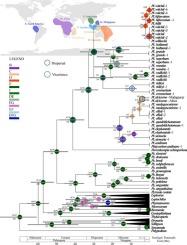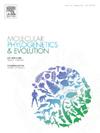Phylogenomic analyses of the pantropical Platycerium Desv. (Platycerioideae) reveal their complex evolution and historical biogeography
IF 3.6
1区 生物学
Q2 BIOCHEMISTRY & MOLECULAR BIOLOGY
引用次数: 0
Abstract
Platycerium is a genus of pantropical epiphytic ferns consisting of ca. 18 species and are highly sought after by horticultural enthusiasts. Although the monophyly of this genus has been well supported in previous molecular studies, as an intercontinentally disjunct genus, the origin and distribution pattern of Platycerium were elusive and controversial. This is mainly due to limited taxon sampling, a plastid representing only a single coalescent history, the lack of fossil evidence, and so on. Here, by utilizing genome-skimming sequencing, transcriptome sequencing, and flow cytometry, we integrated chloroplast genomes, data of single-copy nuclear genes, ploidy levels, morphology, and geographic distribution to understand the species phylogeny and the evolutionary and biogeographic history of Platycerium. Our major results include: (1) based on both plastid and nuclear datasets, Platycerium is consistently resolved into three fully supported clades: the Afro-American (AA) clade, the Javan-Australian (JA) clade, and the Malayan-Asian (MA) clade. The AA clade and MA clade are further divided into three and two subclades, respectively; (2) a large amount of gene tree conflict, as well as cytonuclear discordance, was found and can be explained by hybridization and incomplete lineage sorting, and most of the hybridization hypotheses represented ancient hybridization events; (3) through molecular dating, the crown age of Platycerium is determined to be at approximately 32.79 Ma based on the plastid dataset or 29.08 Ma based on the nuclear dataset in the Middle Oligocene; (4) ancestral area reconstruction analysis from different datasets showed that Platycerium most likely originated from Indochina; (5) current distribution patterns are resultant from long-distance dispersals, ancient orogeny, and an ancient climate event; and (6) species diversification was driven by polyploidization, dispersal, and hybridization. This study presented here will help understand the evolution of tropical plant flora and provide a reference for the cultivation and breeding of staghorn ferns.

泛热带桔梗科(Platycerioideae)的系统发生组分析揭示了其复杂的进化和历史生物地理学。
桔梗属(Platycerium)是泛热带附生蕨类植物,约有 18 个种,深受园艺爱好者的喜爱。虽然该属的单系性在以前的分子研究中得到了很好的支持,但作为一个洲际间不相连的属,Platycerium 的起源和分布模式一直难以捉摸并存在争议。这主要是由于分类群取样有限、质体仅代表单一的聚合历史、缺乏化石证据等原因造成的。在此,我们利用基因组脱脂测序、转录组测序和流式细胞仪,整合了叶绿体基因组、单拷贝核基因数据、倍性水平、形态学和地理分布,以了解桔梗的物种系统发育、进化和生物地理历史。我们的主要成果包括(1)基于质粒和核数据集,Platycerium被一致解析为三个完全支持的支系:非洲-美洲支系(AA)、爪哇-澳大利亚支系(JA)和马来亚-亚洲支系(MA)。AA支系和MA支系又分别分为3个亚支系和2个亚支系;(2)发现了大量的基因树冲突以及细胞核的不一致性,可以用杂交和不完全的世系分类来解释,大多数杂交假说代表了古老的杂交事件;(3)通过分子测年,确定桔梗的冠龄约为32.3)通过分子测年,根据质粒数据集确定桔梗的冠年龄约为 32.79 Ma,根据核数据集确定其冠年龄约为 29.08 Ma,位于中新世;(4)通过不同数据集的祖先区域重建分析表明,桔梗很可能起源于印度支那;(5)目前的分布模式是远距离扩散、古造山运动和古气候事件的结果;(6)物种多样化是由多倍体化、扩散和杂交驱动的。本研究有助于了解热带植物群的演化过程,并为鹿角蕨类植物的栽培和育种提供参考。
本文章由计算机程序翻译,如有差异,请以英文原文为准。
求助全文
约1分钟内获得全文
求助全文
来源期刊
CiteScore
7.50
自引率
7.30%
发文量
249
审稿时长
7.5 months
期刊介绍:
Molecular Phylogenetics and Evolution is dedicated to bringing Darwin''s dream within grasp - to "have fairly true genealogical trees of each great kingdom of Nature." The journal provides a forum for molecular studies that advance our understanding of phylogeny and evolution, further the development of phylogenetically more accurate taxonomic classifications, and ultimately bring a unified classification for all the ramifying lines of life. Phylogeographic studies will be considered for publication if they offer EXCEPTIONAL theoretical or empirical advances.

 求助内容:
求助内容: 应助结果提醒方式:
应助结果提醒方式:


